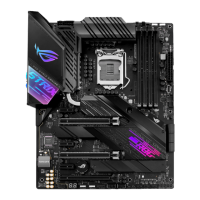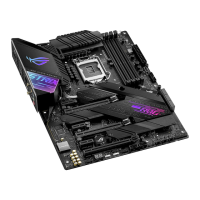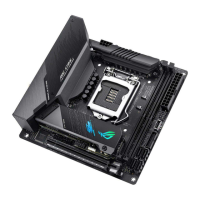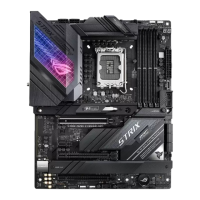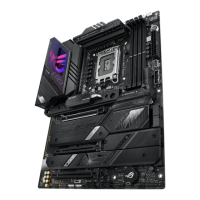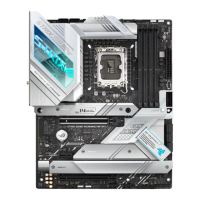
Do you have a question about the Asus STRIX Z270G GAMING and is the answer not in the manual?
| Form Factor | Micro ATX |
|---|---|
| Socket | LGA 1151 |
| Chipset | Intel Z270 |
| Memory Slots | 4 |
| Max Memory Support | 64 GB |
| PCI Express x16 Slots | 2 |
| PCI Express x1 Slots | 2 |
| SATA 6Gb/s Ports | 6 |
| M.2 Slots | 2 |
| USB 3.1 Gen 2 Ports | 2 |
| USB 3.1 Gen 1 Ports | 6 |
| USB 2.0 Ports | 6 |
| Multi-GPU Support | NVIDIA 2-Way SLI, AMD 3-Way CrossFireX |
| Integrated Graphics | Yes |
| LAN | Intel I219-V |
| Audio | SupremeFX 8-Channel High Definition Audio |
| RAID Support | Yes (0, 1, 5, 10) |
| Memory Speed | 3866MHz (OC) |
Precautions to prevent electrical shock hazard and ensure safe operation.
Guidelines for safe handling and installation of the motherboard and components.
Outlines the structure and content of the user guide, chapter by chapter.
Directs users to ASUS website and other documentation for additional details.
Explains the meaning of symbols like DANGER, CAUTION, IMPORTANT, and NOTE.
Explains how bold text, italics, and key notations are used in the manual.
Details socket type, supported CPU generations, and Intel Turbo Boost Technology.
Specifies the Intel Z270 Chipset used on the motherboard.
Lists DDR4 memory support, maximum capacity, and XMP profile.
Details the number and type of PCIe slots available for expansion cards.
Specifies support for NVIDIA SLI and AMD CrossFireX technologies.
Lists integrated graphics processor support and multi-VGA output options.
Details the SATA ports and M.2 socket specifications and features.
Details the Intel I219-V Gigabit LAN and ROG GameFirst Technology.
Details Wi-Fi and Bluetooth specifications and version support.
Details the ROG SupremeFX S1220A CODEC and audio features.
Lists USB 3.0, USB 2.0, and USB 3.1 ports and controllers.
Lists exclusive ROG features like RAMCache II and GameFirst IV.
Details performance optimization, EZ DIY, Q-Design, and Gamer's Guardian features.
Lists Aura Lighting Control, 3D Printing Friendly design, AI Suite 3, and AI Charger.
Lists all connectors available on the rear I/O panel.
Lists all internal connectors on the motherboard for various components.
Lists various BIOS features like UEFI, EZ Flash, and CrashFree BIOS.
Lists manageability features like WfM2.0, DMI3.0, and WOL.
Lists software utilities included on the support DVD.
Lists supported operating systems and specific requirements.
Specifies the motherboard's form factor and dimensions.
Identifies the main product included in the package.
Lists the various SATA and other cables provided in the package.
Lists various accessories like I/O shield, screws, and stickers.
Specifies the ROG motherboard support DVD.
Mentions the user guide as part of the package documentation.
Illustrates a typical PC chassis used for building a system.
Illustrates a power supply unit required for system operation.
Shows an Intel 1151 compatible CPU fan for cooling.
Shows an Intel 1151 compatible CPU.
Illustrates DIMM modules for system memory.
Shows a SATA hard disk drive for storage.
Illustrates a graphics card for display output.
Shows a Phillips head screwdriver for assembly.
Illustrates an optional SATA optical disc drive.
Shows a bag of screws used for mounting components.
Provides an overview of the motherboard and its features.
Lists essential precautions before installing components or changing settings.
Illustrates the physical layout of the motherboard and its components.
Details the LGA1151 socket and the process for installing the CPU correctly.
Explains the DDR4 DIMM slots and the proper installation of memory modules.
Discusses memory configurations, compatibility, and optimal usage recommendations.
Details the specifications and numbering of the PCIe expansion slots.
Explains VGA configuration for PCIe slots and IRQ assignments for motherboard devices.
Explains the function of the Clear RTC RAM jumper for clearing CMOS settings.
Describes the CPU Over Voltage jumper for adjusting CPU voltage settings.
Explains the POST State LEDs which indicate the status of key components during boot.
Details the Intel SATA 6 Gb/s connectors for hard drives and RAID configuration.
Explains the front panel audio connector (AAFP) and the USB 3.1 front panel connector.
Details the USB 3.0 connector for additional ports and the TPM connector for security.
Explains USB 2.0 connectors and the thermal sensor connector for temperature monitoring.
Details CPU, optional CPU, water pump, and chassis fan connectors.
Explains the 24-pin EATXPWR and 8-pin EATX12V power connectors for the PSU.
Details the system panel connector for power button, LEDs, and reset button.
Explains the M.2 sockets (M.2_1 and M.2_2) for M.2 SSD installation.
Details the RGB headers for connecting RGB LED strips.
Introduces the steps for assembling a PC system using the motherboard.
Provides a step-by-step guide for installing the motherboard into the PC chassis.
Details the correct procedure for installing the CPU into the LGA1151 socket.
Guides the installation of the CPU heatsink and fan assembly for cooling.
Explains the process for installing and removing DIMM memory modules.
Details how to connect the ATX power supply plugs to the motherboard.
Illustrates how to connect SATA hard disk drives and optical drives.
Explains the connection of front panel connectors for audio, USB, and power/reset switches.
Guides the installation of PCIe x16 and PCIe x1 expansion cards.
Details the installation process for the HYPER M.2 x4 expansion card.
Provides instructions for installing M.2 SSD modules onto the motherboard.
Explains how to connect the ASUS 2T2R dual band Wi-Fi antenna.
Guides the installation of 3D printed parts onto the motherboard's 3D Mount.
Illustrates the rear panel connectors and provides a numbered list of their functions.
Explains how to connect headphones, microphones, and speakers to the audio ports.
Guides the initial system startup process, including power-on self-tests (POST).
Explains how to properly shut down or put the system into sleep/soft-off mode.
Explains the role of BIOS, its interface, and when to adjust settings.
Details how to enter BIOS Setup and navigate its screens and modes.
Describes the EZ Mode interface for basic system information and quick adjustments.
Introduces the Advanced Mode interface for detailed BIOS configuration options.
Explains the BIOS menu bar structure, main items, and submenu navigation.
Details features like Language selection, My Favorites, Q-Fan Control, and EZ Tuning Wizard.
Explains how to set fan profiles or manually configure fan operating speeds.
Guides using EZ Tuning Wizard for easy overclocking and RAID setup.
Explains how to save and access frequently used BIOS items for personalization.
Covers basic system info, date/time, language, and security settings.
Details options for configuring CPU overclocking, memory frequency, and voltage.
Explains CPU-related settings like Hyper-threading and Power Management Control.
Covers Platform Misc, System Agent (SA), and PCH configurations.
Details SATA controller modes (AHCI/RAID) and SMART self-test options.
Explains configuration for PCIe lanes, HD Audio, M.2 modes, USB power, and RGB lighting.
Covers APM, Network Stack, HDD/SSD SMART, and USB configuration options.
Displays system temperature, power status, and allows fan setting adjustments.
Allows configuration of boot speed, boot order, and CSM support.
Provides access to utilities like ASUS EZ Flash 3 and Secure Erase.
Explains how to securely erase SSD data to restore factory performance levels.
Allows saving, loading, and managing multiple BIOS settings profiles.
Displays information about the installed graphics card and recommended PCIe slot configuration.
Options to load default values, save changes, or discard changes and exit BIOS.
Introduces utilities for updating the motherboard BIOS and the associated risks.
Details how to update the BIOS using a USB flash drive or the internet.
Explains the auto-recovery tool for restoring BIOS files from a DVD or USB drive.
Introduces the motherboard's support for RAID 0, 1, 5, and 10 configurations.
Explains the concepts of RAID 0 (striping), RAID 1 (mirroring), RAID 5, and RAID 10.
Guides the installation of SATA hard disks for creating a RAID array.
Details how to navigate to and configure Intel Rapid Storage Technology in the BIOS.
Provides step-by-step instructions for creating a RAID volume using the BIOS utility.
Explains how to enter and use the Intel Rapid Storage Technology Option ROM utility.
Guides the creation of a RAID driver disk for OS installation.
Contains FCC, Canadian, and other regional compliance statements for the device.
Details FCC rules compliance and guidelines for operation and interference.
Covers Canadian compliance statements including ICES-003 and RSS standards.
Mentions the VCCI compliance statement for Japan.
Includes a warning statement for Korea.
Provides information on REACH regulations and responsible product disposal.
Details RF exposure requirements, wireless radio use restrictions, and safety guidelines.
States FCC compliance for Bluetooth wireless transmission.
States Canadian compliance for Bluetooth wireless transmission.
Mentions wireless compliance statement for Taiwan.
States RF equipment regulations for Japan, particularly for outdoor use.
Provides the license terms for Google software used in the product.
Lists contact details for ASUS headquarters, technical support, and regional offices.
Formal declaration of product conformity with FCC specifications, including representative signature.





